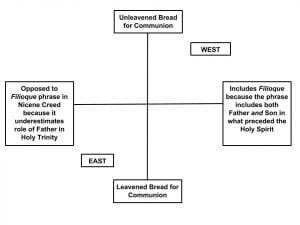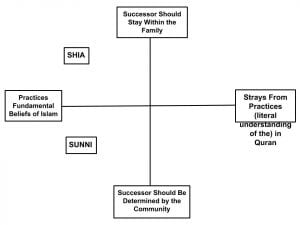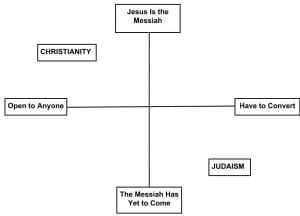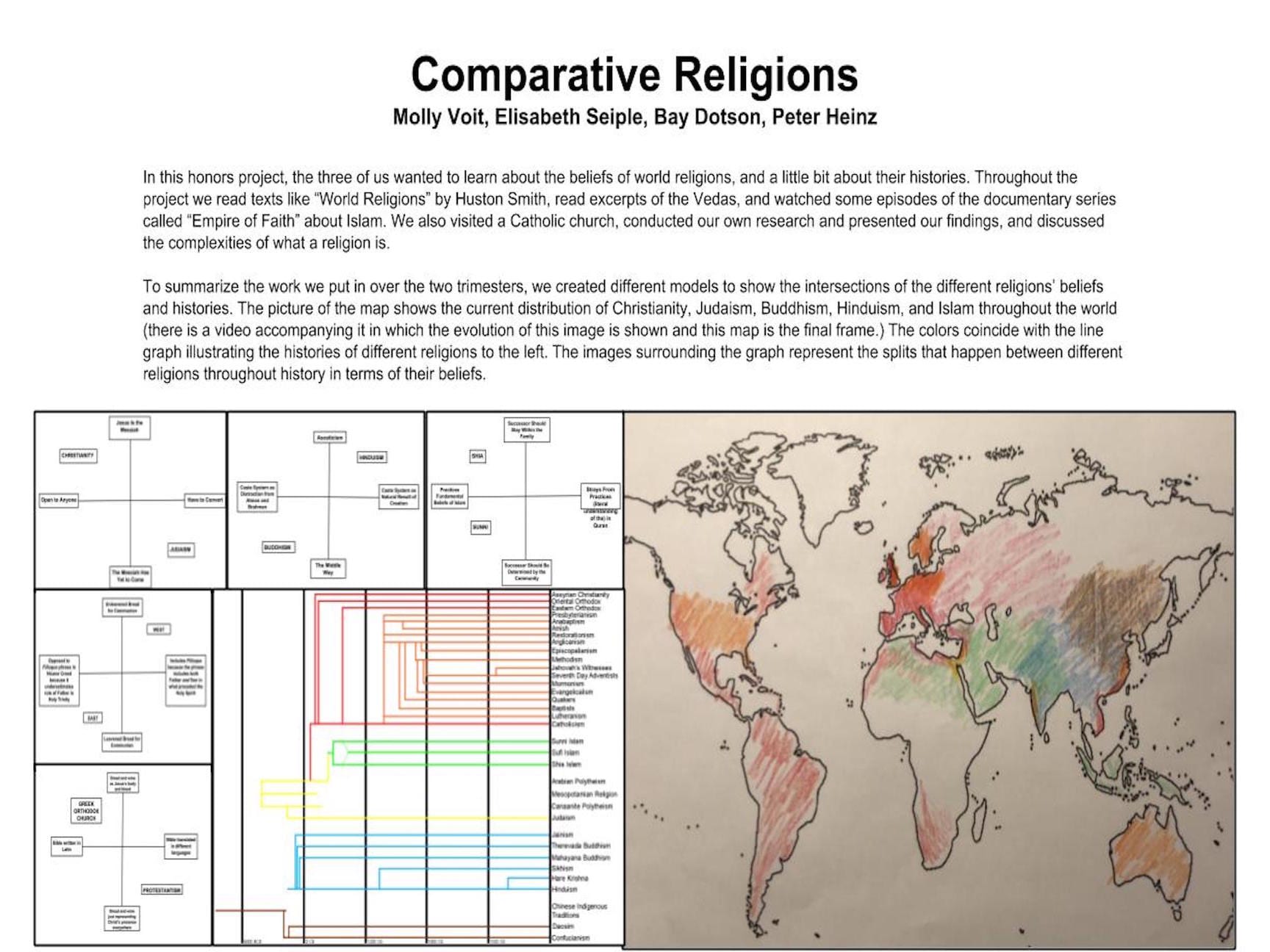Project by: Molly Voit (11th Grade), Elisabeth Seiple (11th Grade), Bay Dotson (11th Grade)
Project Advisor: Peter Heinz
Student(s)’s Advisor(s): Karyn Silverman, Jacqueline Baker, Shafeiq Bakish
We read a number of key religious texts along with “World’s Religions” by Huston Smith. We discussed what constitutes a world religion, and the belief systems and cultures they create. We also learned a little bit of the history of each religion. In the second trimester of the project, we deepened our understanding of the religions we covered in the first trimester and learned about new ones. We completed a comparative review of all that we learned.
Update After Trimester 1 Process Reflection:
Throughout the first trimester, we studied what religion is, the beliefs and theories of Hinduism, Buddhism, Judaism, and Christianity. We wanted to continue discussing other religions and deepening our understanding of what we have already learned. Specifically, we want to visit a Buddhist temple and other religious institutions, study Islam, and learn about cults. After this learning, we then want to complete the comparative aspect of our project to summarize what we have learned.
One part of our honors project in the first trimester each of us creating our own presentations on a certain religion:
Religions we’ve covered:
- Hinduism
- Buddhism
- Judaism
- Catholicism
- Christian Orthodoxy
- Protestantism
- Islam
Bibliography:
- The Bible: We read excerpts from the Bible throughout our discussion of Christianity. Specifically to study the commandments,
- The Bhagavad Gita: We read the Bhagavad Gita during our discussion of Hinduism in order to explore the origins of Hindu beliefs and the concepts of Dharma and caste.
- The Torah: Molly used excerpts from the Torah in her presentation on Judaism.
- The Qur’an: Bay read chapters of the Quran for our discussion.
- World Religions by Huston Smith: We read multiple chapters from this book to use as introductions to our research on specific religions.
Presentations:
One part of our honors project in the first trimester each of us creating our own presentations on a certain religion:
Catholicism:
https://docs.google.com/presentation/d/17DOrsMABHEdUxNGQXEa3S6h73CwH9SfHgqYaMtFjkOs/edit?usp=sharing
Judaism:
https://docs.google.com/presentation/d/1fwet7PDI-RJ3M2yxL3JwqjawZRnRS_LlqqbzjpxCR_U/edit?usp=sharing
Eastern Orthodoxy:
Powerpoint (unavailable)
Field Trips we’ve taken:
St. Anthony’s Church (Sullivan St.)
St. Anthony’s is a Roman Catholic church established by Italian immigrants in 1866. It was the first church founded for Italian immigrants in America. We visited the church in order to learn about Catholic architecture and worship practices. While there we discussed the importance of saints, and the use of stained glass windows to tell biblical stories when people can’t read the Bible.
Next Steps:
In trimester two we hope to use all the knowledge that we acquired throughout trimester one in order to visually compare the religions we studied. We were thinking that we would create a series of charts and graphs, that show the intersections, timelines, and belief spectrums of many religions.
Trimester 2 Reflection:
This trimester, we have focused on representing what we learned throughout the course of this honors project. We especially wanted to show how the various religions we talked about intersected throughout history and in their beliefs. We each choose a type of graph we would focus on creating for the trimester.
Molly was tasked with representing the intersections of the religions we studies in terms of beliefs.





Elisabeth created a graph representing the timeline of the religions:
Bay created a video chart of how the religions spread throughout time.
These helped us to visualize everything we had learned for the past two trimesters and organize the knowledge we gained. Through doing this we were also exposed to how real comparative religion scholars might conduct their research/the kinds of graphs and assignments they would be creating.
Additionally, this project required a lot of collaboration between the three of us, as well as Peter. The topics we tackled were sometimes difficult to understand and offered new perspectives than we were used to; we all had to approach our learning with open minds and be eager to ask questions. For example, in the very beginning when we were discussing Hinduism, we learned new vocabulary that described different aspects of the religion (Brahman, Atman, Maya, Dharma, Karma, and many more). In order to be respectful of the topic, as well as deepening our understanding of the nuances of Hinduism, we had to ask a lot of questions to push each other’s learning and accept the ideas that we were not familiar with. The need to collaborate and be patient emerged again when deciding how to represent what we had learned on a single poster. Since there are four of us in the group, there were all kinds of ideas flying around and it was difficult to land on one. After some time fleshing out the ideas together, we chose a course of action that required each of us to create something individually while also relying on each other’s projects to complete them. As we began actually making them, we realized that it was more complicated than we initially thought and had to really communicate what we were doing and feeling about our work. Despite the bumps in the road, our poster shows the hard work and nuanced thinking we have done over the course of this project, as well as we each brought our individual selves to it. Without the challenges that working together to understand difficult subjects creates, we would not have learned the value of communication, open-mindedness, and collaboration that we will use for the rest of our lives.
=============================================
TRIMESTER 2 PROJECT PROPOSAL
Please write a description of the project you are proposing. Why do you want to take this on, and what do you hope to learn?
We started this honors project in the first trimester but did not cover all of the topics we hoped to so we want to continue it. This trimester, we want to deepen our understanding of the religions we covered last trimester and learn about new ones. Then to summarize what we have learned we want to complete the comparative aspect of the project and look at everything we’ve learned together.
Critical thinking, creativity, citizenship and courage are essential LREI learning values. Explain how you’ll draw on at least one of these values to complete your proposed project?
We will be using critical thinking by thinking deeply and asking meaningful questions about the religions we are studying.
What is your proposed outcome? How will you be able to demonstrate successful completion of this Project? How do you plan to share your learnings with the larger LREI community (e.g., exhibit of work, poster of learnings, performance, etc.)?
Our goal is to have a better understanding of the world religions, and at the end, we will hold a debate on world religions using current events and the knowledge we’ve gained from the project.
Please provide a general outline that indicates your work plan for the trimester? What are some of the key project benchmarks (i.e., goals that will help to ensure that you finish the project)?
We plan to expand on what we covered last trimester including the main three monotheistic religions and potentially some other ones. We also hope to take some field trips to religious institutions/places of worship.
When do you plan on meeting?
Wednesday X Blocks
=================================================================
PROJECT PROPOSAL
Project by: Elisabeth Seiple (11th Grade), Molly Voit (11th Grade), Bay Dotson (11th Grade)
Project Advisor: Peter Heinz
Student(s)’s Advisor(s): Shafeiq Baksh, Karyn Silverman, Jacqueline Baker
Please write a description of the project you are proposing. Why do you want to take this on, and what do you hope to learn?
We want to read “World’s Religions” by Huston Smith, and discuss what constitutes a world religion, and the belief systems and cultures they create. We would also like to learn a little bit of the history of each religion.
What is your proposed outcome? How will you be able to demonstrate successful completion of this Project?
Our goal is to have a better understanding of the world religions, and at the end we will hold a debate on world religions using current events and the knowledge we’ve gained from the project.
When do you plan on meeting?
Wednesday X-Block
Update After Trimester 1 Process Reflection:
Throughout the first trimester, we have studied what religion is, the beliefs and theories of Hinduism, Buddhism, Judaism, and Christianity but want to continue discussing other religions and deepening our understanding of what we have already learned. Specifically, we want to visit a Buddhist temple and other religious institutions, study Islam, and learn about cults. After this learning, we then want to complete the comparative aspect of our project to summarize what we have learned.
Religions we’ve covered:
Hinduism
Buddhism
Judaism
Catholicism
Christian Orthodoxy
Protestantism
Islam
Bibliography:
The Bible
We read excerpts from the Bible throughout our discussion of Christianity. Specifically to study the commandments,
The Bhagavad Gita
We read the Bhagavad Gita during our discussion of Hinduism in order to explore the origins of Hindu beliefs and the concepts of Dharma and caste.
The Torah
Molly used excerpts from the Torah in her presentation on Judaism.
The Qur’an
Bay read chapters of the Quran for our discussion.
World Religions by Huston Smith
We read multiple chapters from this book to use as introductions to our research on specific religions.
Presentations:
One part of our honors project in the first trimester was each of us creating our own presentations on a certain religion:
Catholicism:
https://docs.google.com/presentation/d/17DOrsMABHEdUxNGQXEa3S6h73CwH9SfHgqYaMtFjkOs/edit?usp=sharing
Judaism:
https://docs.google.com/presentation/d/1fwet7PDI-RJ3M2yxL3JwqjawZRnRS_LlqqbzjpxCR_U/edit?usp=sharing
Eastern Orthodoxy:
Powerpoint (unavailable)
Field Trips we’ve taken:
St. Anthony’s Church (Sullivan St.)
St. Anthony’s is a Roman Catholic church established by Italian immigrants in 1866. It was the first church founded for Italian immigrants in America. We visited the church in order to learn about Catholic architecture and worship practices. While there we discussed the importance of saints, and the use of stained glass windows to tell biblical stories when people can’t read the Bible.
Next Steps:
In trimester two we hope to use all the knowledge that we acquired throughout trimester one in order to visually compare the religions we studied. We were thinking that we would create a series of charts and graphs, that show the intersections, timelines, and belief spectrums of many religions.
Trimester 2 Reflection:
This trimester, we have focused on representing what we learned throughout the course of this honors project. We especially wanted to show how the various religions we talked about intersected throughout history and in their beliefs. We each choose a type of graph we would focus on creating for the trimester, for example Molly was tasked with representing the intersections of the religions we studies in terms of beliefs, Elisabeth created a graph representing the timeline of the religions, and Bay created a video chart of how the religions spread throughout time. This helped us to visualize everything we had learned for the past two trimesters and organize the knowledge we gained. Through doing this we were also exposed to how real comparative religion scholars might conduct their research/the kinds of graphs and assignments they would be creating.




Sounds great! Approved.
Approved
approved